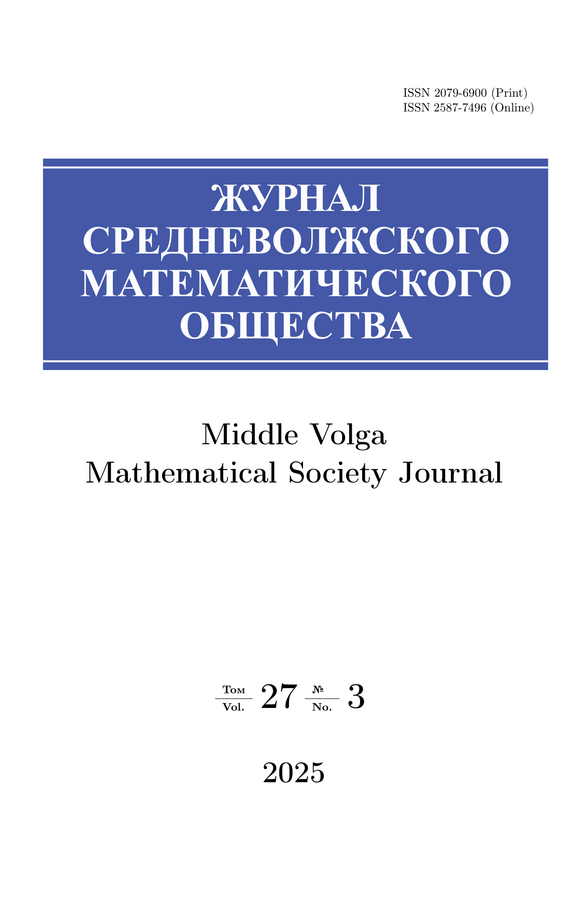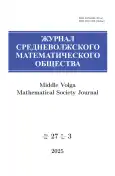Zhurnal Srednevolzhskogo Matematicheskogo Obshchestva
Journal publishing original papers and reviews on new significant results of scientific research in fundamental and applied mathematics. Articles about most significant events in mathematical life in Russia and abroad are also published here.
Media registration certificate: ПИ № ФС 77 - 71362 от 17.10.2017
Editor-in-Chief
Vladimir Fedorovich Tishkin, corresponding member of RAS, Dr. Sci. (Phys.-Math.), Full professor
Frequency / Access
4 issues per year / Open
Included in
Higher Attestation Commission List, RISC, Scopus, Math-Net, zbMATH
Journal Section:
- Mathematics
- Applied mathematics and mechanics
- Mathematical modeling and computer science
- Mathematical life
Current Issue
Vol 27, No 3 (2025)
- Year: 2025
- Published: 30.09.2025
- Articles: 6
- URL: https://journal-vniispk.ru/2079-6900/issue/view/22463
Full Issue
Mathematics
Iterated function systems whose attractors are Cantor
Abstract
In this paper we consider classical iterated function systems (IFS) consisting of a finite number of contracting mappings for a complete metric space. The main goal is to study the class of IFSs whose attractors are Cantor sets, i.e. perfect totally disconnected sets. Important representatives of this class are totally disconnected IFSs introduced by Barnsley. We have proposed other definitions of a totally disconnected IFS and proved their equivalence to the Barnsley definition. Sufficient conditions for IFS to be totally disconnected are obtained. It is shown that injectivity of mappings from an IFS implies the perfection of the attractor and its uncountability. Also it is proved that if the mappings from an IFS are injective and the sum of their contraction coefficients is less than one, then the attractor is a Cantor set. In general case, these conditions do not guarantee totally disconnectedness of an IFS. Meanwhile, it is shown that if an IFS consists of two injective mappings and the sum of their contraction coefficients is less than one, then the IFS is totally disconnected. Examples of IFS attractors are constructed, demonstrating that conditions of the proven theorems are only sufficient but not necessary.
 287-301
287-301


Estimation of solutions of neutral type systems with two incommensurate delays
Abstract
This paper presents the algorithm for estimating solutions of differential- difference systems of neutral type with two incommensurate delays in the neutral part. It is worth mentioning an important assumption about the commutativity of matrices in the left-hand side of the system. The idea of the approach is to represent the system’s solutions in terms of initial functions and the fundamental matrix and then to construct an exponential estimate for this representation. At the first step, the system’s initial conditions are set. Next, the system is rewritten in an integral form and the delay operator is introduced. After recursive application of this operator to the right-hand side of obtained system, the system’s solutions are expressed via binomial coefficients, initial functions and the fundamental matrix. At the final step these expressions are used to make an exponential estimate of the solution. It is proved that the estimate of the fundamental matrix of the system also has an exponential form. In practice, the proposed method allows optimizing the control choice for neutral-type delay systems in sense of one of the crucial characteristics of the controlled systems, i.e. the overshoot value.
 302-314
302-314


On generalized Romanovsky operators with partial integrals in the space of continuous functions
Abstract
The paper contains sufficient conditions for the action of generalized and linear generalized partial integral Romanovsky operator in the space of continuous functions defined on an n-dimensional parallelepiped. Continuity of these operators is established in case of their action in the space of continuous functions and, in a more general case of continuous kernels of operators with values in the space of measurable and Lebesgue integrable functions. Estimates are obtained for the norms of the operators mentioned. The dependence of the estimate for the norm of a linear Romanovsky type operator with generalized partial integrals on the space dimension and on the norm of continuous kernels of generalized partial integral Romanovsky operators with values in the space of measurable and Lebesgue integrable functions is shown. The properties established are applied to the study of linear generalized partial integral equations of Romanovsky type, in particular, to the study of generalized partial integral equation of n-connected Markov chains.
 315-324
315-324


Method of optimal placement of approximation nodes
Abstract
In this article we propose a method for optimizing the arrangement of approximation nodes and use Runge function as an example to implement this approach. The method is based on the idea of nonlinearity of space along the axes of Cartesian coordinate system. To control the nonlinearity, we use a polynomial function with a parameter uniformly distributed over the segment $[0,1]$. A comparative analysis of the following standard methods of selecting nodes for the approximation of Runge function was carried out: uniformly along the abscissa axis, uniformly along the ordinate axis, uniformly along the curve length, and by Chebyshev's nodes. To compare the Lagrange interpolation polynomials, we estimate the approximation errors of Runge's function. Graphs of the constructed Lagrange's polynomials for five and seven interpolation nodes selected in different ways are presented. To select the optimal arrangement of approximation nodes of the proposed method, we compile an objective function, whose minimization ensures optimal arrangement of nodes $x_i$ along the abscissa axis. The arrangement of approximation nodes along the ordinate axis is determined by calculating the $y_i$ values basing on the original Runge's function. As a result, we found nodes that provide minimal deviations from the original approximated Runge's function. The paper considers cases of five and seven approximation nodes. To visualize the results obtained, we provide graphs of original Runge's function and of its approximation, indicating the optimal nodes found. This method is stable to increasing the number of nodes, whose arrangement is optimized each time and adapted to the original function.
 325-340
325-340


A square-root method for identifying the parameters of discrete-time linear stochastic systems with unknown input signals
Abstract
The paper proposes a new square-root gradient-based parameter identification method for discrete-time linear stochastic state-space systems with unknown input signals. A new algorithm is developed for calculating the values of the identification criterion and its gradient. The approach is based on a square-root modification of the Gillijns – De Moor method and uses numerically stable matrix orthogonal transformations. Unlike the existing solutions, this paper uses original methods for differentiating matrix orthogonal transformations. A new sensitivity model is constructed and theoretically justified, that allows calculating the values of the identification criterion gradient by using partial derivatives of state vector estimates based on identified parameters. The main results include new equations for the square-root sensitivity model and a square-root algorithm for calculating the values of the identification criterion and its gradient. Numerical experiments were performed in MATLAB for example of solving the numerical identification problem of a stochastic diffusion model with unknown boundary conditions. The effectiveness of the proposed algorithm is confirmed by comparison of gradient-based and gradient-free methods. The results of numerical experiments demonstrate efficiency of approach proposed which can be used to solve practical problems of identifying the parameters of mathematical models represented by discrete-time state-space linear stochastic systems, in the absence of any prior information about the input signals.
 341-363
341-363


Mathematical modeling and computer science
Modeling the trapping and transporting of cargo in a fluid by a system of self-assembled magnetic particles controlled by an external field
Abstract
The dynamics of this process is modeled based on experiments on the capture and movement of a load by a system of self-organizing particles in a magnetic field. The transport system of particles is a structure in the form of one closed chain (two-dimensional case) or two parallel closed chains (three-dimensional case). As a result of the action of the external field, the particles are set in rotation and move translationally. Hydrodynamic interaction between all particles and the load, which does not interact with the external field, is taken into account. The mathematical model includes equations of viscous fluid hydrodynamics and particle dynamics in the approximation of small Reynolds numbers. Numerical modeling and visualization of the obtained results are performed using a specially developed software package. The performed numerical calculations confirmed the possibility of capture and transfer of the load in the case of location of the particle system and the load in the same plane. In the three-dimensional case, the capture of cargo and its movement by the transport structure in the form of parallel chains of particles does not lead to the capture of cargo. The obtained results are in qualitative agreement with the experiments. The proposed model can be used to calculate the dynamics of a system of particles self-organizing into closed chains in a liquid in the presence of foreign bodies.
 364-379
364-379












